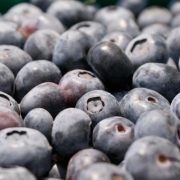Mexico: rising exports of berries
By Luis Bringas
Over 50 years EF Schumacher, economist and thinker born in Germany, I think a partnership in the UK called Intermediate Technology Development Group (Group for the development of intermediate technologies), based on his book published in 1973, Small is beautiful ( small is beautiful), whose objectives were to publicize the virtues of micro enterprises that generate their own income without flaunting it. Any resemblance to the undertaking of strawberries is just a coincidence.
Similarly, the British hotel chain Small LuxoryHotels gives priority to small businesses that offer tourist services of high quality at the best price possible. This prestigious chain has over 500 stores in 80 countries. In agriculture the phenomena of globalization of markets have led us to think that the solution lies in establishing large areas of crops to maintain competitiveness. However, by making the potty outside, we see that there are small-scale options that can be profitable enoperaciones 1 to 3 hectares. This is the case of strawberries (or berries as identified in international markets), including blueberry, cherry, raspberry, strawberry, blackberry and sarsaparilla, which can generate an income up to $ 40,000 USD per hectare, becoming one of the best examples of sustainable agriculture associated with the use of resources and social responsibility.
It is curious that the explosive growth of these crops – mainly associated with health issues and environmentalists movements using largely mass communication systems and marketing to reach the minds of consumers who are served by large chains. Another curious fact is that 80% of the strawberries is distributed in packaging oyster (clamshell) and more than 15% is being introduced as frozen or processed product. Certainly the gain is in the bag that dominates the buying impulses in every way.
Unicorns
In a way, small is beautiful, but also becomes large at a time. Not so the modern world? This means that the ideas or thoughts that arise in small companies become market unicorns. Let’s say strawberries, being so small and fragile can now travel long distances even from one hemisphere to another, to be present at the table of consumers around the world. But thanks to whom?
Thanks to technological adaptations, genetic research and the construction of a value chain associated with mass marketing, a select group of companies in six countries (United States, Canada, Mexico, Chile, Argentina and Spain) have managed to build and develop a market valued at more than 10,000 million dollars in a short period of 25 years, is to say that one generation is already bearing fruit.
The prognosis is that strawberry crops may become as popular as apple, banana, avocado, potatoes and tomatoes, which now have the highest consumer preferences ranging from 55 to 83%. Another interesting group consists of cruciferous for its antioxidant properties, broccoli, cauliflower, cabbage and Brussels sprouts, whose performances in fresh, frozen products displaced and currently have preferences between 25% and 57% among consumers. The antioxidants also strawberries, with high concentrations of vitamins and minerals, are located in the middle of the table with preference from 25% to 45%, although they are hardly in his youth.
Speaking of the global export market, strawberries have found a great niche among consumers in the United States, with an import volume of more than 1.3 million tons annually coming from Mexico, Chile, Argentina and Guatemala and distributed to through major retail chains like Costco, Walmart, Safeway, Ahold, Sams and Kruger. According to market research conducted in the US by the ForeingAgriculturalService (FAS), the growth of strawberries in just 15 years has averaged 14% annually, with prices ranging from 4 to 25 dollars per kg depending on the presentation and season.
The second most important market for strawberries corresponds to European countries which have reported annual import volumes of nearly 600,000 tonnes mainly entering the markets of Germany, England, France, Italy and Austria. In this case, Spain, Holland, Belgium and Poland are the main European producers and exporters, and are complemented by exports of Chile, Argentina and Mexico, to supply chains Tesco, Carrefour, Edeka, Asda and Rewe serving the above markets. In European countries, the growth of consumption are more moderate, but have become from 7 to 9% annually. According to European experts, logistics distribution and quality are the factors that bring greater advantages in marketing and growth of 3% for strawberries and 5 to 7% for raspberry, blackberry and blueberry expected.
There is also an emerging market for strawberries in Asian countries mainly China, Japan, South Korea and Singapore. In this area, the cities of Beijing, Shanghai, Hong Kong, Ghanzhou and Dailian are important centers for the distribution of strawberries with annual volumes of more than 45,000 tons, whose growth is estimated at over 50% for the coming years. Other emerging markets correspond to Latin America, led by Brazil, Chile, Argentina and Mexico, where most distribution corresponds to market chains Walmart, Carrefour and Costco, as well as sustainable sourcing of local products that predominate in the high mountain areas .
In all these markets, the main feature is that it is small operations with strict cost control that are based on group funding to strengthen the value chain, safety and traceability. That is, the business with a philosophy of small business, is supported by a well structured primarily generates profitability and reduces market risk process.
Based on this, specialists know that there is a key factor to address market risks ranging from climate change, to pests and diseases, to devaluations and increased competition. The first point in favor of the companies involved in this market is that the per capita consumption in the globalized world is still low and has potential for further growth.
But undoubtedly the most important factor to reduce the risks of genetic research is based on geographic diversification. Seen this way the world is in every corner and only just a little push to roll it. In conclusion, the associative principle of small businesses looking to leverage resources sustainably, has finally given a solution that simultaneously supports the health of consumers. This synergy allows us to say that today – in spite of the momentum of large corporations also’posible small is beautiful.
In a highly technical and competitive environment, participation of Mexican producers has increased rapidly, from $ 618 million in 2010, reaching $ 1.500 billion in the last cycle autumn-winter, with an annualized increase more than 15% over the last five years. The figures reported by the Ministry of Economy and endorsed by the Export Promotion Promexico indicate that the total exports in 2014que reached $ 1.236 billion, 40% is strawberries (fresh and frozen), 37% are raspberry, 18% of blackberry; supplemented with 6% corresponding to new cranberry crops. While in 2015, the figures for the value of exports rose to $ strawberry 1, 501 million.
Meanwhile, the Agricultural Information Service (SIAP-SAGARPA) has been reported in the recent agrifood expectations Forum held last April 15, the surface of strawberries in this country, which for more than 20 years ago is part of the Treaty North American Free Trade Agreement NAFTA called by its acronym in English-it has grown from 10,500 hectares in 2010 to close to 25,000 hectares in 2015, representing an annualized increase of 27%.
Apparently -the success of this new productive sector -this supported by exemplary Mexican exports of avocado, tomato, grape and espárrago- representing large shares of the world market. Therefore, it is estimated that more than 600 thousand tons of strawberries registered in the recent cycle autumn-winter 2015-2016 is mainly harvested in the states of Michoacan, Jalisco and Baja California.
In this region of West and North Pacific, highlights the participation of the National Association of berries deexportadores (ANEBERRIES) built in 2010 for the production and marketing companies among which AgranaFruit, Alpasa, Berrymex, Berrie’sParadaise, BQ Fruit , Corporate Altex, Driscoll, Export Berry, Berries Exifrut ,, Group, Guimarra, Hortifruit, SB Berrys, Splendor, Sunnyridge, Universal Berries and others that have achieved since its integration represent the interests of producers and seek support government to establish mechanisms to promote and market protection.
It is noteworthy that by the analysis performed by the ANEBERRIES can be predicted that the volume of production podríaduplicarse by 2020 with production from other regions among which Sonora, Sinaloa, Chihuahua, Coahuila, Colima, Guanajuato, Mexico, Puebla and Veracruz, where currently already being tested adaptation of varieties of blackberry, raspberry and blueberry in that order of importance. Even they are testing with organic substrates in warm regions in the states of Oaxaca and Sinaloa to produce blueberries in the months of July to September.
The analysis of members ANEBERRIES reveals that crops strawberries have a high growth potential, which however must be supported in the correct assessment of the resources available, to select the most appropriate technology to ensure efficient production and profitable. ANEBERRIES efforts are focusing on integrated control records and quality certification for greater recognition of the international market.
One of the great advantages of Mexican producers, is that unlike other countries, production can be done practically all year, leaving free the rainy season of July and August.
It is noteworthy that there is now a differentiation in production systems, in which farms more technicalization totaling approximately 15,000 hectares, are concentrated in a 90% increase in exports, with 75% for USA and Canada, 10% to EU and 5% to Asia; while the rest of farms in the open, is channeled to the domestic market consumption. Almost total export is handled in fresh, although the market for processed and frozen is increasing.
Where as the production of strawberries generates an occupancy of 6 persons per hectare, this sector employs approximately 150,000 workers in rural areas, representing an important sustained economic income in foreign exchange earnings from exports and growing domestic market. In this regard, the international fruit and vegetable Alliance for corporate social responsibility (AHIFORES), is managing a series of measures to strengthen investments by exporting companies the benefit of workers in the field, such as medical conferences, dental and school system for children of workers.
Finally, one of the points of interest that have been identified through interviews, is that strengthening export activities, the Government of Michoacan with the support of SAGARPA and the Ministry of Economy, are developing a modernization project for the Port Lazaro Cardenas, Michoacan, which will achieve a greater number of exports to all continents. This is based on the fact that this region is consolidated 85% of avocado exports, 45% of guava, 29% of lime and 93% of the strawberries, specifically blackberry and raspberry. Thus, it would be consolidating a highly competitive sector, whose outlook is really positive.
Sources: ANEBERRIES, SIAP, Secretary of Economic Development of Michoacan
















